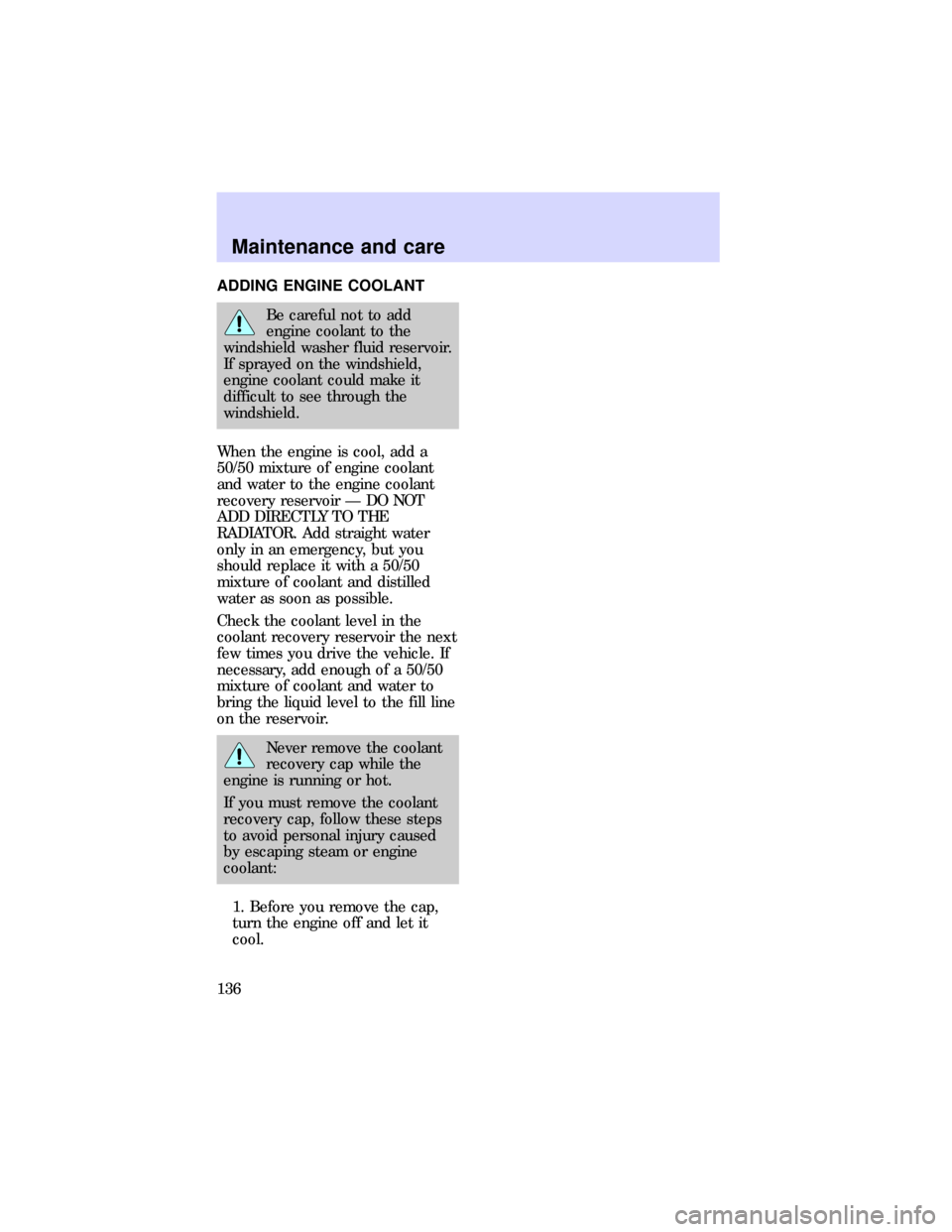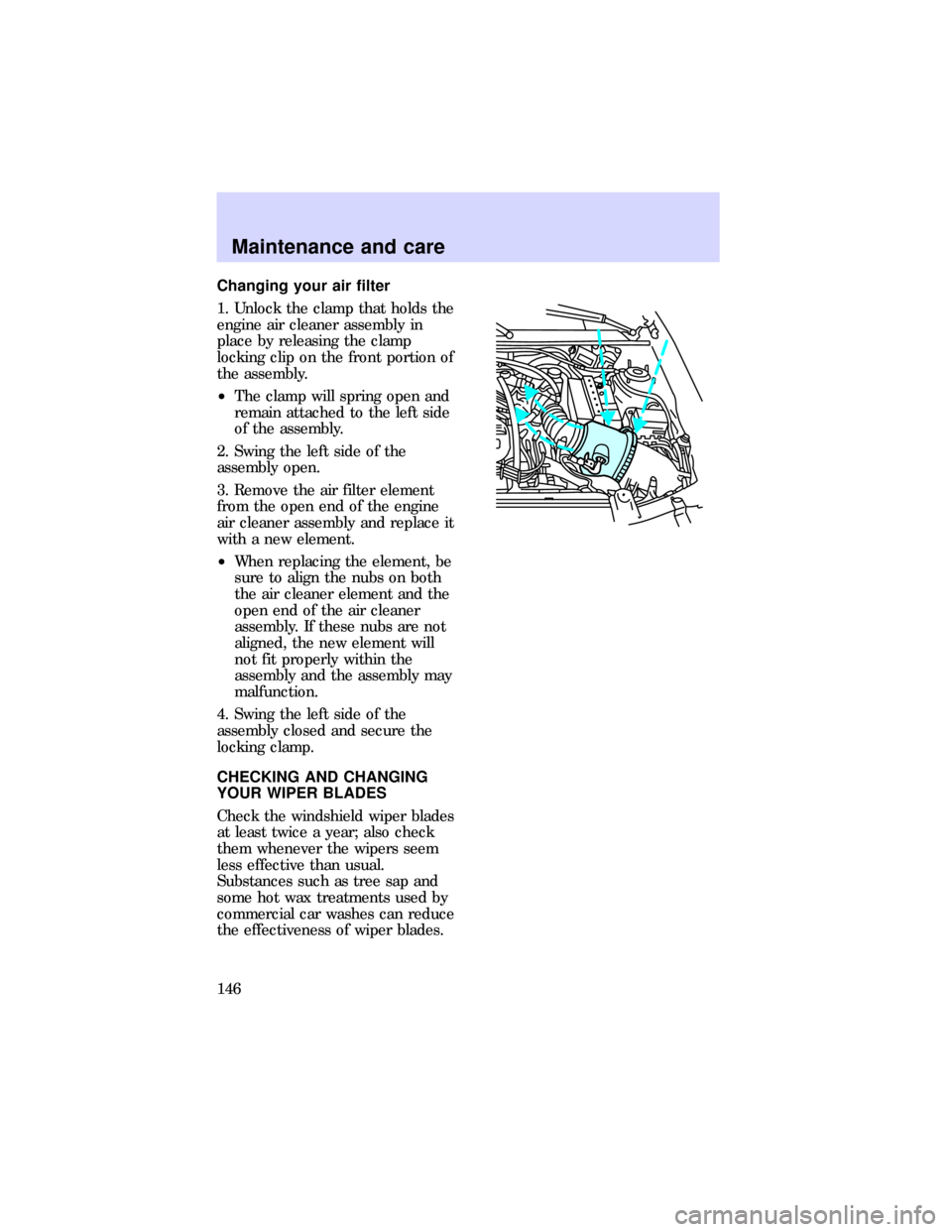Page 135 of 191
Washer fluid for the windshield
reservoir
The vehicle's windshield washer
fluid reservoir is located on the
passenger side of the engine
compartment. If washer fluid needs
to be added to the reservoir:
²Lift the windshield reservoir
cover.
²Add enough washer fluid to fill
the reservoir.
Washer fluid for the liftgate (if
equipped)
The wagon's rear reservoir is
located on the passenger side of
the storage compartment. Remove
the access cover to locate the
washer reservoir cap. The reservoir
must be filled slowly to allow
trapped air to escape.
Maintenance and care
135
Page 136 of 191

ADDING ENGINE COOLANT
Be careful not to add
engine coolant to the
windshield washer fluid reservoir.
If sprayed on the windshield,
engine coolant could make it
difficult to see through the
windshield.
When the engine is cool, add a
50/50 mixture of engine coolant
and water to the engine coolant
recovery reservoir Ð DO NOT
ADD DIRECTLY TO THE
RADIATOR. Add straight water
only in an emergency, but you
should replace it with a 50/50
mixture of coolant and distilled
water as soon as possible.
Check the coolant level in the
coolant recovery reservoir the next
few times you drive the vehicle. If
necessary, add enough of a 50/50
mixture of coolant and water to
bring the liquid level to the fill line
on the reservoir.
Never remove the coolant
recovery cap while the
engine is running or hot.
If you must remove the coolant
recovery cap, follow these steps
to avoid personal injury caused
by escaping steam or engine
coolant:
1. Before you remove the cap,
turn the engine off and let it
cool.
Maintenance and care
136
Page 137 of 191

2. When the engine is cool, wrap
a thick cloth around the cap and
turn it slowly, counterclockwise
to the first stop.
3. Step back while the pressure
releases.
4. When you are sure that all the
pressure has been released, use
the cloth to press the cap down,
turn it counterclockwise, and
remove it.
Use Ford Premium Engine Coolant
E2FZ-19549-AA (in Canada,
Motorcraft CXC-8-B) or an
equivalent premium engine coolant
that meets Ford Specification
ESE-M97B44-A. Ford Premium
Engine Coolant is an optimized
formula that will protect all metals
and rubber elastomers used in
Ford cooling systems for 4 years or
50,000 miles (80,000 km).
Do not use alcohol or methanol
antifreeze or any engine coolants
mixed with alcohol or methanol
antifreeze. Do not use
supplemental coolant additives in
your vehicle. These additives may
harm your engine cooling system.
The use of an improper coolant
may void the warranty of your
vehicle's engine cooling system.
Recycled Engine Coolant
Ford Motor Company recommends
that Ford and Lincoln-Mercury
dealers use recycled engine
coolant produced by
Ford-approved processes. Not all
coolant recycling processes
Maintenance and care
137
Page 138 of 191

produce coolant which meets Ford
specification ESE-M97B44-A, and
use of such coolant may harm
engine and cooling system
components.
Always dispose of used automotive
fluids in a responsible manner.
Follow your community's
regulations and standards for
recycling and disposing of
automotive fluids.
Coolant Refill Capacity
To find out how much fluid your
vehicle's cooling system can hold,
seeRefill capacities for fluidsin
the Index.
Have your dealer check the engine
cooling system for leaks if you
have to add more than a quart
(liter) of engine coolant per
month.
Severe Winter Climate
If you drive in extremely cold
climates (less than -34ÉF [-36ÉC]),
it may be necessary to increase the
coolant concentration above 50%.
Refer to the chart on the coolant
container to ensure the coolant
concentration in your vehicle is
such that the coolant will not
freeze at the temperature level in
which you drive during winter
months. Never increase the engine
coolant concentration above 60%.
Leave a 50/50 mixture of engine
coolant and water in your vehicle
year-round in non-extreme
climates.
Maintenance and care
138
Page 139 of 191
CHECKING AND ADDING
POWER STEERING FLUID
Check the power steering fluid at
least twice a year by completing
the following steps:
1. Start the engine.
2. When the engine coolant
temperature gauge reaches the
normal zone, turn off the engine.
3. Visually inspect the fluid level in
the power steering reservoir.
4. If necessary, add power steering
fluid until the fluid level reaches
MAX. Do not overfill the power
steering reservoir.
²As a maintenance precaution,
visually inspect the lines and
hoses of the power steering
system for leaks and damage.
²If new fluid is frequently
required, consult a qualified
service technician.
CHECKING AND ADDING
TRANSAXLE FLUID
Checking and adding automatic
transaxle fluid
Check the automatic transaxle
fluid according to the owner
maintenance checks in theService
Guide.
ON
II
ACC
I
LOCK
0
START
III
C
H
Maintenance and care
139
Page 144 of 191

If the electrolyte level becomes
low, refill the battery with distilled
water. If necessary, distilled water
may be substituted with tap water
that is not hard and does not have
a high mineral or alkali content. If
the battery needs water quite
often, have the charging system
checked for a possible malfunction.
Your vehicle is equipped with a
battery saver control feature
designed to prevent your battery
from accidental wear down due to
doors left ajar. For information on
the system and how it works, see
Interior overhead lampin this
chapter.
Because your vehicle's engine is
electronically controlled, some
control conditions are maintained
by power from the battery. When
the battery is disconnected or a
new battery is installed, the
computer must ªrelearnº its idle
conditions before your vehicle will
drive properly. To begin this
process:
1. Put the gearshift in P
(automatic transaxle) or N
(manual transaxle).
2. Turn off all accessories and start
the vehicle.
3. Let the engine idle for at least
one minute.
4. The relearning process will
automatically complete as you
drive the vehicle.
²If you do not allow the engine to
relearn its idle, the idle quality
Maintenance and care
144
Page 145 of 191
of your vehicle may be adversely
affected until the idle is
eventually relearned.
²If the battery has been
disconnected or a new battery
has been installed, the clock and
preset radio stations must be
reset once the battery is
reconnected.
²Always dispose of used
automotive batteries in a
responsible manner. Follow your
community's standards for
disposal. Call your local
recycling center to find out
more about recycling automotive
batteries.
CHECKING AND CHANGING
YOUR AIR FILTER
If the vehicle is operated in very
dusty or sandy areas, replace the
filter more often than the
recommended intervals.
Do not drive without an air
filter; this could result in
excessive engine wear.
Maintenance and care
145
Page 146 of 191

Changing your air filter
1. Unlock the clamp that holds the
engine air cleaner assembly in
place by releasing the clamp
locking clip on the front portion of
the assembly.
²The clamp will spring open and
remain attached to the left side
of the assembly.
2. Swing the left side of the
assembly open.
3. Remove the air filter element
from the open end of the engine
air cleaner assembly and replace it
with a new element.
²When replacing the element, be
sure to align the nubs on both
the air cleaner element and the
open end of the air cleaner
assembly. If these nubs are not
aligned, the new element will
not fit properly within the
assembly and the assembly may
malfunction.
4. Swing the left side of the
assembly closed and secure the
locking clamp.
CHECKING AND CHANGING
YOUR WIPER BLADES
Check the windshield wiper blades
at least twice a year; also check
them whenever the wipers seem
less effective than usual.
Substances such as tree sap and
some hot wax treatments used by
commercial car washes can reduce
the effectiveness of wiper blades.
Maintenance and care
146